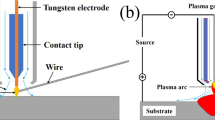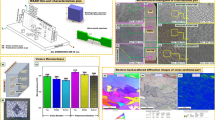Abstract
The plastic deformation ability of aluminum alloys is poor and cracking can easily occur during traditional stamping. Electromagnetic forming is a high-speed forming method that can increase the forming limits of aluminum alloys. However, shape deformation of the part is difficult to control owing to fast deformation speeds and uneven electromagnetic force distribution. In this paper, electromagnetic driven stamping (EMDS) is used that combines electromagnetic forming with traditional stamping is proposed. The deformation process of 5052 aluminum alloy sheets during static and dynamic stamping was analyzed through experimental investigations and numerical simulations. Under dynamic conditions, the forming height of 5052-O aluminum alloy increased by 11.4% compared with quasi-static stamping. The Gurson–Tvergaard–Needleman damage model was adopted to predict deformation and fracture behavior during the stamping process. During dynamic stamping, the strain rate reached 405 s−1, which is much higher than that in quasi-static stamping. With EMDS, the void volume fraction in the cracked region decreased by 17.6% compared with quasi-static stamping. Under a high strain rate, the sheet forming height improved as void formation was inhibited and dimples were more evenly distributed.





















Similar content being viewed by others
Data availability
All data and materials are fully available without restriction.
References
Wang L, Strangwood M, Balint D, Lin J, Dean TA (2011) Formability and failure mechanisms of AA2024 under hot forming conditions. Mater Sci Eng A 528(6):2648–2656
Ko DC, Ko DH, Kim JH, Park JH (2017) Development of a partition panel of an Al6061 sheet metal part for the improvement of formability and mechanical properties by hot forming quenching. Adv Mech Eng 9(2):1–15
Xiong WR, Wang WP, Wan M, Pan L (2014) Effect of the duration of electromagnetic pulse force on the rebound suppression in V-bending experiment. Proceedings of the 6th international conference on high speed forming, pp 335–344
Chu YY, Lee RS, Psyk V, Tekkaya AE (2012) Determination of the flflow curve at high strain rates using electromagnetic punch stretching. J Mater Process Technol 212(6):1314–1323
Xu JR, Lin QQ, Cui JJ, Li CF (2014) Formability of magnetic pulse uniaxial tension of AZ31magnesium alloy sheet. Int J Adv Manuf Tech 72(5):5–8
Fang JX, J. Mo JH, Li JJ (2017) Microstructure difference of 5052 aluminum alloys under conventional drawing and electromagnetic pulse assis-ted incremental drawing. Mater Charact 129:88-97
Su HL, Huang L, Li JJ, Xiao W, Zhu H, Feng F, Li HW, Yan SL (2021) Formability of AA 2219-O sheet under quasi-static, electromagnetic dynamic, and mechanical dynamic tensile loadings. J Mater Sci Technol 70(11):125–135
Li N, Yu HP, Xu Z, Fan ZS, Liu L (2016) Electromagnetic forming facilitates the transition of deformation mechanism in 5052 aluminum alloy. Mater Sci Eng A 673:222–232
Liu DH, Zhou WH, Li CF (2013) Springback control and deformation analysis for electromagnetically assisted bending of U-shaped part. Chin J Nonferrous Met 23(11):3075–3082
Feng F, Li JJ, Chen RC, Huang L, Su HL, Fan S (2021) Multi-point die electromagnetic incremental forming for large-sized sheet metals. J Manuf Process 62:458–470
Cui XH, Zhang ZW, Du ZH, Yu HL, Qiu DY, Cheng YQ (2020) Inverse bending and springback-control using magnetic pulse forming. J Mater Process Technol 27:116374
Su HL, Huang L, Li JJ, Zhang QX, Liu XL, Ma F (2020) On the forming uniformity during a single layer forming of electromagnetic incremental forming. Int J Adv Manuf Tech 107:4561–4572
Cui XH, Mo JH, Li JJ, Zhao J, Zhu Y, Huang L, Li ZW, Zhong K (2014) Electromagnetic incremental forming (EMIF): a novel aluminum alloy sheet and tube forming technology. J Mater Process Technol 214(2):409–427
Cao QL, Du LM, Li ZH, Lai ZP, Li ZZ, Chen M, Li XX, Xu SF, Chen Q, Han XT, Li L (2018) Investigation of the Lorentz-force-driven sheet metal stamping process for cylindrical cup forming. J Mater Process Technol 271:532–541
He M, Li FG, Wang ZG (2011) Forming limit stress diagram prediction of aluminum alloy 5052 based on GTN model parameters determ. Chin J Aeronaut 24(3):378–386
Feng F, Li JJ, Yuan P, Zhang QX, Huang P, Su HL, Chen RC (2018) Application of a GTN damage model predicting the fracture of 5052-O aluminum alloy high-speed electromagnetic impaction. Metals 8(10):1–20
Archut JL, Vinyas Upadhyaya YS (2018) Estimation of damage value of SAE4340 steel and 5A02 aluminium alloy. Int J Auto Mech Eng 15(2):5211–5220
Jenab A, Green DE, Alpas AT, Golovashchenko SF (2017) Experimental and numerical analyses of formability improvement of AA5182-O sheet during electro-hydraulic forming. J Mater Process Technol 255:914–926
Funding
This work was supported by the National Natural Science Foundation of China (Grant Number: 51775563), and the Project of State Key Laboratory of High Performance Complex Manufacturing, Central South University (ZZYJKT2020-02).
Author information
Authors and Affiliations
Contributions
Zhihao Du: methodology, investigation, experiments, writing original draft.
Xiaohui Cui: methodology, investigation, writing—review and editing.
Huan Yang: investigation.
Wenzhen Xia: investigation.
Corresponding author
Ethics declarations
Ethical approval
Not applicable.
Consent to participate
Written informed consent for publication was obtained from all participants.
Consent to publish
Written informed consent for publication was obtained from all participants.
Conflict of interests
The authors declare no competing interests.
Additional information
Publisher's note
Springer Nature remains neutral with regard to jurisdictional claims in published maps and institutional affiliations.
Rights and permissions
Springer Nature or its licensor (e.g. a society or other partner) holds exclusive rights to this article under a publishing agreement with the author(s) or other rightsholder(s); author self-archiving of the accepted manuscript version of this article is solely governed by the terms of such publishing agreement and applicable law.
About this article
Cite this article
Du, Z., Cui, X., Yang, H. et al. Deformation and fracture behavior of 5052 aluminum alloy by electromagnetic-driven stamping. Int J Adv Manuf Technol 123, 3955–3968 (2022). https://doi.org/10.1007/s00170-022-10446-2
Received:
Accepted:
Published:
Issue Date:
DOI: https://doi.org/10.1007/s00170-022-10446-2




